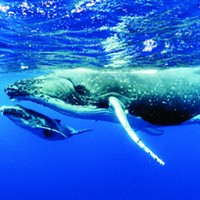Sunken Seaweed's Dual Mission
Stocking shelves and the ocean with seaweed and kelp
By Jennifer Fumiko Cahill [email protected] @jfumikocahill[
{
"name": "Top Stories Video Pair",
"insertPoint": "7",
"component": "17087298",
"parentWrapperClass": "fdn-ads-inline-content-block",
"requiredCountToDisplay": "1"
}
]
While at then Humboldt State University, Torre Polizzi and Leslie Booher were part of a team surveying seaweed along the North Coast, documenting the mass die offs of sea stars and kelp. "That was pretty painful to witness," says Polizzi. The kelp, on which endangered abalone depend, are still being devoured by starving purple urchins, causing a cascading ecological disaster ("Tools in the Toolbox," April 15, 2021). "It's a foundational species. You need that species as a base for all these other species to thrive," he says.
Sunken Seaweed, the aquafarming business the couple founded together in 2017, is rooted in that experience. While the public-facing portion of their work is the still new line of seaweed products on shelves in the North Coast Co-Op, Wildberries and Eureka Natural Foods, Polizzi and Booher are also working to help rebuild the decimated bull kelp, as well as the marine life that so desperately need it.
In the beginning, Sunken Seaweed was based in San Diego, where Polizzi and Booher used "blue economy" grant money, meant to stimulate ocean-related economic endeavors, to test out farming native kelp in San Diego Bay. There, they established how suited green seaweed is for bioremediation, essentially cleaning the water. Seaweed is able, says Polizzi, to "sequester a lot of nitrogen, a lot of phosphorous — it can buffer the Ph [in acidic seawater] and it can also take in organic pollutants."
"We got to do a lot of cool science," says Polizzi, but they were getting burnt out on "the grant game" and were ready to shift to the commercial side of things. However, he says, "one of the issues with San Diego Bay, like many of the bays and estuaries on the West Coast, is it's polluted," largely as the result of industry. "It's important to know where your seaweed comes from because it's a bio-accumulator," absorbing pollutants.
Growing seaweed for food necessitated a move back up to Humboldt, where waters are far cleaner. "This is a really good environment to be growing it in up here in Northern California," says Polizzi, given the cold water, upwelling and hospitably rocky substrate for the kelp to grow on. Seawater intake permits are hard to come by, but Sunken Seaweed was able to lease partial use of the one Hog Island Oyster Co. has for its Humboldt Bay hatchery, and set up a farm in Samoa.
To farm seaweed, Polizzi explains, they take just a few spore packets, similar to the little dots on the underside of a fern's fronds, from blades of wild seaweed, and plant them in one of two ways: offshore farming and tumble culture.
Farming kelp in the ocean requires setting up a line about 5 feet below the water's surface, using weights and buoys at either end, like an underwater laundry line. Once placed on the line, kelp seeds spawn and start to grow. Fast. Bull kelp go from 3 mm babies to 14-foot giants in about a month. "It's like bamboo," says Polizzi. "It's one of the fastest growing organisms on earth." He estimates that at just under half an acre, Sunken Seaweed's bay farm can grow about 8,000 to 10,000 pounds of kelp a year.
The eight bubbling tanks on land in Samoa, each holding 1,200 gallons of water, are for growing dulse and other kelp with tumble culture. Seawater is pumped from the bay through a filter to keep out critters and a "beefy" UV sterilizer to nix bacteria, before entering the tanks, where air is pumped in to keep the water moving. Tumbling the dulse, nori and sea lettuce (occasionally sea grapes or sea truffle, as well) allows them to evenly photosynthesize. As new water is pumped in, the old goes back out to sea a little cleaner.
Using tumble culture, "It grows ridiculously fast," says Polizzi. "I'll double the biomass in a week." The tanks yield another 18,000 pounds of seaweed per year, for a total of 26,000 to 28,000 pounds per year for the whole operation. "You can't talk to any other farmer and expect people to grow that much food in that small a space. And it's a nutrient dense food," says Polizzi. "It's a lot of bang for your buck. ... No fresh water, no pesticides. It's basically just sunlight and seawater."
This past year, 80 percent of the crop went to a restoration project in Mendocino County funded by Sea Grant, which buys decoy kelp from farmers. "They are trying to bait urchins ... out of certain areas where they think restoration can happen, to bring them out of a starvation state and back to how they should be," which is hiding out, instead of ravenous and constantly hunting for food. Getting bull kelp from farmers means it doesn't have to be stripped from other parts of the ocean to redirect urchins away from the newly planted babies.
On the retail food side, Sunken Seaweed has been selling in local markets and at the Arcata Farmers Market since August. Polizzi says the red dulse is popular partly for its nutrients. "It's 25 percent protein, and it's a complete protein with amino acids, 44 trace minerals and a plethora of vitamins," particularly b vitamins. He notes seaweed has always been a staple food of Indigenous people along the California coast, including tribes in Humboldt County. And it carries a lot of umami flavor. In fact, bake it until crispy and, he says, "I'm not gonna say it tastes just like bacon — it's reminiscent of bacon."
Sunken Seaweed offers fresh dulse, green sea lettuce and nori, which Polizzi says will stay fresh in the refrigerator for about a week. "We will typically dry the bull kelp blades and mill them and make a flake spice mix with other species we grow." He describes it as "a bougie furikake" made with alder wood smoked dulse instead of dried bonito fish, keeping it vegan. Local restaurants have added it to their menus, including Moonstone Grill, the Eatery and Tavern 1888.
The company's website sunkenseaweed.com offers recipes, as well. This one pairs mushrooms with fresh dulse for plant-based surf-and-turf flavors with the option of adding the Parmigiano-Reggiano. For this recipe, Sunken Seaweed adapted a Saveur mushroom pasta with a simple olive oil sauce. Lobster mushrooms can be substituted with fresh porcini, matsutake or oyster mushrooms, or dried varieties rehydrated in warm water or broth.
Dulse and Lobster Mushroom Pasta
Ingredients
¾ cup extra-virgin olive oil, divided, plus more for drizzling
1 medium white onion, finely diced (¾ cup)
3 finely minced garlic cloves
1 ½ pounds fresh mushrooms, brushed clean and cut or torn into bite-sized pieces
4 ounces fresh dulse, rinsed and roughly chopped
1/3 cup dry white wine
1 pound fresh fettuccine or mafaldine pasta
½ cup coarsely chopped Italian parsley
¼ cup Parmigiano-Reggiano, shaved in wide ribbons
Bring a large pot of generously salted water to a boil.
Meanwhile, in a large skillet set over medium-high heat, add 2 tablespoons of olive oil. When the oil shimmers, add the onions and cook, stirring occasionally, until they are softened and translucent, 5-7 minutes. Add the garlic, then stir in the mushrooms. Continue cooking until they are lightly browned in places and just beginning to soften, about 4 minutes.
Add fresh dulse and cook for an additional 1-2 minutes. The dulse will turn from burgundy to green.
Add the wine, bring to a boil, and cook until the liquid has reduced, about 3 minutes. Add the remaining olive oil, turn the heat down to medium-low, cover the pan, and continue cooking, stirring occasionally, until the mushrooms are very tender and the oil is infused with their flavor, about 15-20 minutes.
When the mushrooms are nearly done, cook the pasta according to package directions, draining 1 minute early and reserving 1 cup of the cooking liquid. Stir the pasta into the mushroom mixture, adding reserved cooking liquid as needed. Stir in the parsley.
Transfer the pasta and mushrooms to a large serving platter. Top with shaved Parmigiano-Reggiano, an additional drizzle of olive oil and sprigs of fresh dulse. Serve and enjoy.
Jennifer Fumiko Cahill (she/her) is the arts and features editor at the Journal. Reach her at (707) 442-1400, extension 320, or [email protected]. Follow her on Instagram @JFumikoCahill.
Speaking of...
-

Resentencing, CASA Kids and Freaky Fish
Apr 19, 2024 -

Eco Cemeteries, Flags, Impacts and Foods
Apr 12, 2024 -

Making Change: Love
Apr 11, 2024 - More »
more from the author
-
Hole Food
- Apr 27, 2024
-
SCOTUS on the Homeless, CPH Protest and Local Entertainment
- Apr 26, 2024
-
Look Up for Rooftop Sushi
- Apr 19, 2024
- More »

































